Orchids, belonging to the Orchidaceae family, are one of the largest and most diverse plant families, with over 25,000 species and more than 100,000 hybrids and cultivars. These fascinating plants are found on every continent except Antarctica, showcasing a vast array of forms, sizes, and colors adapted to a wide range of habitats, from tropical rainforests to cold Himalayan slopes.
I’m continually struck by the astonishing spectrum represented within this vast family.
With species of orchids burgeoning well into the tens of thousands, my journey has taken me to the far corners of the earth (metaphorically speaking) as I’ve come to appreciate the staggering orchid diversity that nature offers.
Each type of orchid, from the familiar to the exotic, boasts its own unique set of characteristics, charming gardeners and collectors alike with their delicate structures and vibrant colors.
With this guide to orchids, I invite you to join me in uncovering the mysteries and marvels of these botanical jewels.
Whether you’re an experienced horticulturist or a casual observer, there is something new and exciting to learn about the different types of orchids.
From their exceptional adaptability to their intricate beauty, every orchid tells a story, one of evolution, survival, and natural splendor.
The passion for these blooms extends beyond aesthetics; it’s about understanding the special nuances that each flower presents.
Recognizing the requirements and joys of cultivating such a diverse group of plants is my invitation to you, the gateway to a world of orchids awaiting your discovery.
Key Takeaways
- Discover the vast orchid diversity spanning over 25,000 species worldwide.
- Learn about the orchid types that are best suited to your climate and expertise level.
- Understand the unique characteristics that set different species of orchids apart.
- Embrace the beauty and complexity of growing various types of orchids.
- Utilize this comprehensive guide to orchids to expand your knowledge and collection.
- Explore the striking variety and form each orchid offers to enthusiasts and novices alike.
Some Common Questions
As an orchid enthusiast, I receive numerous inquiries about growing orchids and orchid care. From understanding an orchid’s lifespan to achieving continuous orchid blooms, the queries are as diverse as the orchids themselves.
There are also plenty of questions about orchid lighting preferences, and how best to replicate their natural habitats in our homes or gardens. Below, I’ll address some of the most common questions I encounter.
What is the Hardest Orchid To Grow
For those seeking a challenge in orchid care, the Masdevallia species often tops the list. These temperamental beauties require precise environmental conditions, including specific temperature and humidity levels that can be difficult to maintain, especially in non-tropical climates.
What is the Easiest Orchid To Grow
On the opposite end of the spectrum, the Phalaenopsis orchid, commonly known as the moth orchid, is lauded for its forgiving nature. Its resilience and simplicity make it a beloved choice for novices looking to start growing orchids with less anxiety about perfection in orchid care.
What is the Lifespan of an Orchid
When it comes to an orchid’s lifespan, the range is vast. Some species may grace us with their presence for just a few weeks, while others can adorn our living spaces for several decades, with the right care and conditions.
Which Orchid Blooms Continuously
Continuous bloomers like some Phalaenopsis species are the gems of any orchid collection. These varieties can produce continuous orchid blooms throughout the year, gratifying even the most impatient growers.
Do Orchids Prefer Sun or Shade
Oftentimes, people are curious about orchid lighting preferences. The answer to whether orchids prefer the sun or shade is not one-size-fits-all. For example, Dendrobium orchids demand high light levels, but Phalaenopsis species thrive in more muted, diffused lighting conditions.
Orchid Types and Species: Defining Beauty in Diversity
My journey through the world of orchids has led me to discover an incredible variety that spans across continents and climates. From lush tropical forests to arid desert landscapes, orchids have adapted to thrive in an array of environments, each type boasting unique characteristics that fascinate and inspire.
The Immense Range of Orchid Species
With over 25,000 species, the orchid family is a testament to the wonders of natural evolution. The sheer number of different types of orchids is daunting, yet it speaks to the adaptability and resilience of these enchanting plants.
My exploration has taught me the significance of identifying orchid types, a skill that intertwines botanical science with the aesthetic enjoyment of these blooms.

Distinguishing Between Popular Orchid Types
Among the myriad species, certain orchids have captured the hearts of enthusiasts worldwide.
The Phalaenopsis, also known as the moth orchid, and the Cattleya are household names for good reason. Their breathtaking blooms and relative ease of care make them popular choices.
However, the Dendrobium genus, with its over one thousand species, illustrates the vast genetic diversity and beauty of different types of orchids, each with its own story and place in the orchid family.
Native and Exotic Species Across the World
The distinction between native orchid species and exotic orchid species often blurs, as globalization allows for orchids to be grown far from their natural habitats.
Yet, there’s a particular charm in discovering an orchid-like the Encyclia tampensis that has adapted to the urban landscape of South Florida. These native species serve as a reminder of how orchids can be both global wanderers and emblematic of a specific region’s natural heritage.
From the protective embrace of cloud forests to the welcoming warmth of a hobbyist’s greenhouse, orchids continue to enchant and educate us.
The key to their beauty lies not just in their visual splendor, but in the stories of survival and adaptation that each bloom represents.
Getting to Know Phalaenopsis Orchids: The Beginner’s Favorite
As I delve into the realm of growing orchids for beginners, I find myself frequently recommending Phalaenopsis orchids, commonly known as moth orchids.
Not only are they a visual delight with their elegant, wide-ranging colors and patterns, but they are also celebrated for their exceptional resilience and easy-care nature.
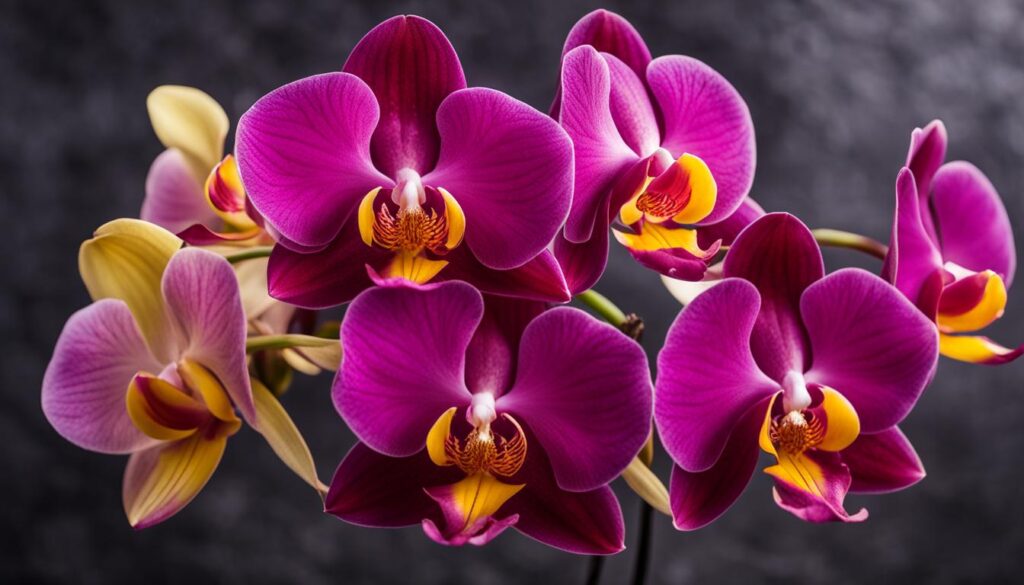
Being one of the common orchid species found in home gardens, their prolonged blooming cycle makes them a continuous source of joy for any orchid enthusiast.
Moth orchids thrive in conditions that are easy to replicate indoors, which is why they are often spotlighted when discussing growing orchids for beginners.
- Phalaenopsis orchids are adaptable, thriving in moderate room temperatures and lower light conditions than many other orchid species.
- Their watering requirements are straightforward, with a preference for drying out between waterings to prevent root rot.
- Known for their longevity, Phalaenopsis orchid blooms can grace your home for several months, far outlasting common cut flowers.
Moth orchids are not only beginner-friendly but also incredibly versatile, making them perfect for both a meticulously curated orchid collection and a simple decorative touch in a living space.
The Enchanting World of Cattleya Orchids: Guidelines for Care and Maintenance
As an admirer of Cattleya orchids, often hailed as one of the most popular orchid types, I’m compelled by their extravagant beauty and the exhilarating challenge they present in terms of orchid care and orchid maintenance.
These exotic orchid species are a true spectacle with their rich palette and captivating scents, making them beloved among collectors and hobbyists alike.
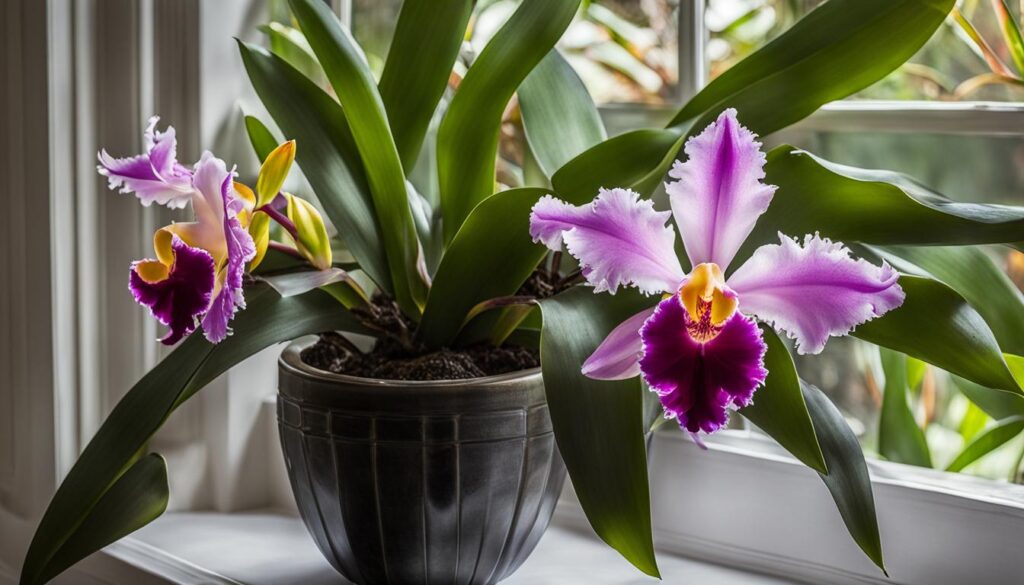
Renowned for their dramatic floral displays and complex care requirements, Cattleya orchids are a genus that commands both respect and dedication. For those looking to incorporate these botanical jewels into their lives, understanding their unique needs is key to fostering a thriving orchid habitat.
- Light Requirements: Cattleyas thrive in bright, indirect light. Sufficient light is essential for robust growth and bloom cycle initiation.
- Watering Routine: Allow the potting medium to dry slightly between watering, but avoid complete desiccation. These orchids appreciate humidity yet demand good air circulation to prevent root rot.
- Temperature and Humidity: Aim for a daytime temperature range of 70-85°F (21-29°C) and slightly cooler evenings to encourage flowering. Maintain humidity levels between 40-70% if possible.
- Fertilization Plan: A balanced fertilizer, employed during the active growing season, supports lush growth and prolific blossoming.
- Potting Considerations: Repot Cattleyas every few years in a well-draining medium to support their epiphytic nature and to freshen the substrate, taking care not to damage their sensitive root system.
Patience and attention to detail in the cultivation of Cattleya orchids can yield spectacular results.
With these guidelines, you can nurture your own enchanted orchid garden, brimming with the striking allure of Cattleyas—gems among exotic orchid species.
Discovering the Resilient Dendrobiums: Color Diversity and Growth Habits
As I delve deeper into the fascinating world of orchids, the Dendrobium genus stands out with over a thousand species, each showcasing a breathtaking array of colors and distinctive silhouettes.
My passion for these plants grows with their reputation for resilience and adaptation to various environments. Their striking beauty, coupled with the nuances of orchid growth habits, makes cultivating orchids a unique horticultural adventure.

Understanding the Unique Shapes and Colors of Dendrobiums
One cannot help but be awed by the color diversity found within Dendrobium orchids. They paint the spectrum from pure whites to deep purples, and their blooms are nothing short of a horticulturist’s dream.
Not only does this enrich the visual palette of any collection, but it also demonstrates the fascinating variability among different types of orchids. I’ve observed that some species feature rare patterns and hues, earning acclaim from institutions like the American Orchid Society.
Practical Tips for Cultivating Dendrobium Orchids
When it comes to cultivating orchids, particularly the Dendrobiums, understanding specific care requirements is crucial for their successful growth.
Their top-heavy nature often necessitates staking to support the weight of the blooms. Additionally, these orchids typically thrive in bright sunlight, which poses an exciting challenge for orchid enthusiasts looking to provide the optimal conditions for their plants to flourish.
- Ensure adequate lighting, Dendrobiums exhibit a preference for bright, indirect light.
- Maintain a consistent watering schedule, allowing for periods of dryness between watering.
- Use a well-draining potting medium to accommodate the orchid’s delicate root system.
- Fertilize regularly with a balanced orchid fertilizer to support robust growth and blooming.
| Species | Color | Preferred Light Conditions | Bloom Duration |
|---|---|---|---|
| Dendrobium Phalaenopsis | Pinks to Purples | High, indirect light | 4-6 weeks |
| Dendrobium Nobile | White with purple center | Bright to medium light | 6-8 weeks |
| Dendrobium Kingianum | Varied shades | High light with some direct sun | Up to 10 weeks |
In my experience, patience and a genuine interest in learning orchid growth habits are the keys to successfully cultivating orchids, especially the magnificent Dendrobiums.
With each plant, I’ve gained insights that not only further my own growth as a gardener but also enrich my living space with vibrant displays of floral artistry.
Oncidium Orchids: Beauty Resembling Dance
My journey through the world of orchids has led me to a particularly captivating group known as Oncidium orchids, the stars of the orchid family famed for their resemblance to tiny dancers mid-performance.
Unlike some popular orchid types, Oncidiums are especially known for their vibrant, multi-flowered sprays which have the animated appearance of a joyous crowd. This charming trait is perhaps why they’re affectionately nicknamed ‘dancing lady orchids‘.
For those new to identifying orchid types, recognizing an Oncidium is relatively straightforward. These delightful blossoms are characterized by their unique structure – a narrow base that flares out into a broad, wavy lip and, often, a patterned facade.
I’ve been quite taken by the variety known as ‘Sharry Baby’, which infuses the air with a subtle chocolate scent, a rare and pleasing attribute in the floral world.
Oncidium orchid care is an engaging topic for any orchid enthusiast. In my experience, they are more forgiving than one might expect.
These orchids thrive on bright but indirect light and appreciate a good balance of moisture and air circulation around their roots. However, overwatering can be detrimental, leading to the dreaded leaf deformities that can steal away their beauty.
Here’s a quick care guide for these graceful plants:
- Light: High but indirect light conditions.
- Water: Allow to dry slightly between waterings.
- Humidity: Maintain around 40%-60% for optimum health.
- Temperature: Appreciates warmth, with ideal temperatures between 65-85°F (18-29°C).
- Feeding: Fertilize weekly or bi-weekly with a balanced orchid fertilizer during active growth phases.
Oncidiums can be quite the show-stoppers in any orchid collection, given the right attention, and it’s a joy to watch their vibrant sprays dance above the foliage – a true representation of natural beauty in motion.
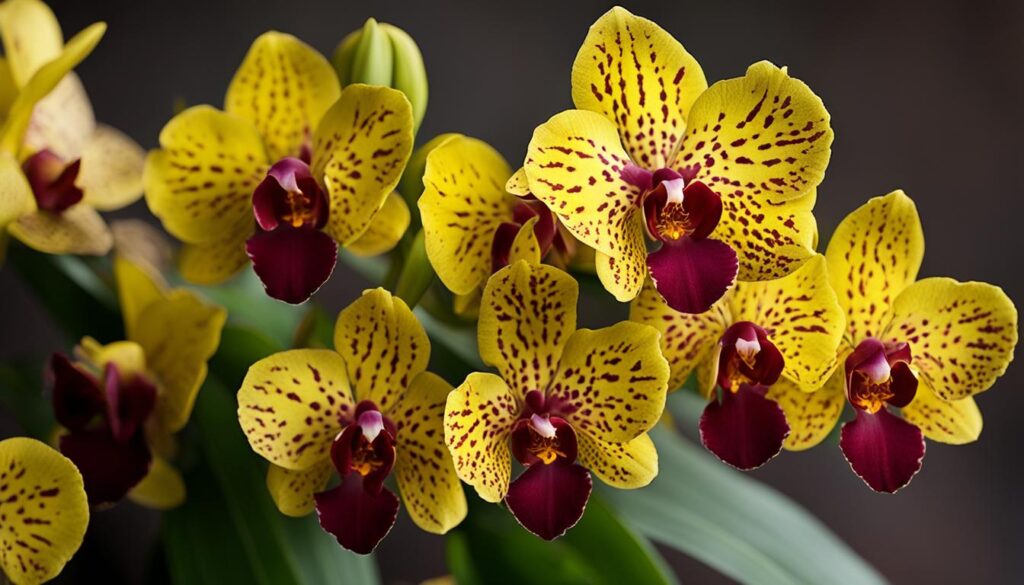
As a personal testimonial to the wonder these orchids bring, I can say that having Oncidiums in my collection has been nothing short of a delightful encounter with the poetic side of horticulture.
Their care, while a bit particular, is well compensated by the unrivaled elegance they lend to my living space.
Delving into Vanda Orchids: Maximizing Their Blooming Potential
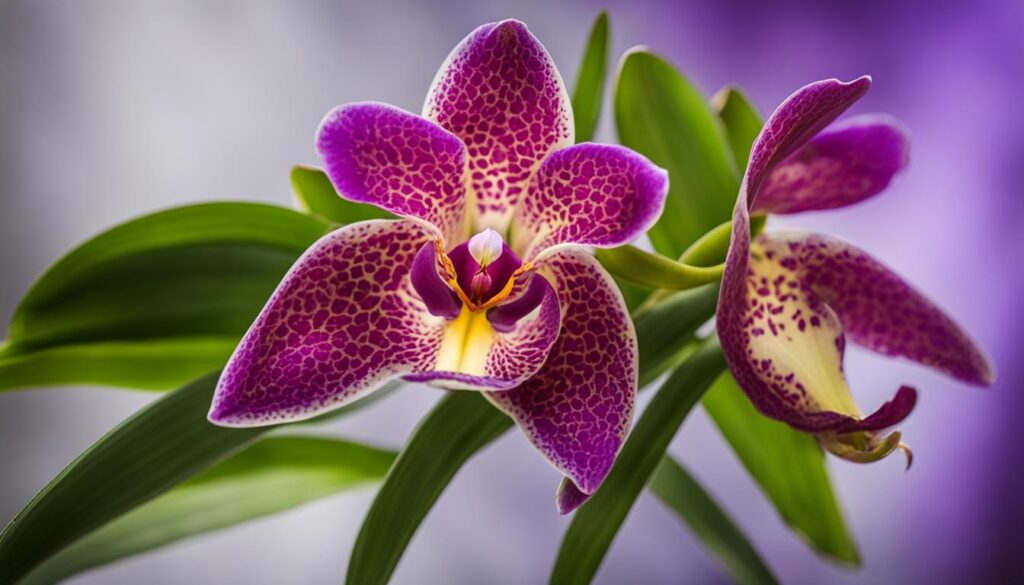
As an orchid enthusiast, my journey has introduced me to many exotic orchid species, but few match the vivid allure and promise of Vanda orchids.
Renowned for their ability to produce long-lasting flowers, these ornamentals are a testament to nature’s opulence. To ensure that I am maximizing orchid blooms, I had to learn and adapt my care routine to meet the specific needs of these regal plants.
Orchid baskets have become an essential part of my Vanda care ritual. These baskets allow for the ample airflow and drainage that Vandas crave. It’s a delicate balance, ensuring that while their roots are free to dangle, they still trap enough moisture from the air, especially in the warm climates they love.
By understanding the unique demands of Vanda orchids, you unfold the potential to witness an extraordinary display of blooms that can captivate any orchid lover’s heart. It’s about giving these exotic beauties a slice of their native habitat.
Here’s a quick guide I’ve put together to help you understand how to replicate the ideal conditions for your Vanda orchids:
| Condition | Description | Tips for Care |
|---|---|---|
| Light | High light levels | Place in bright, indirect sunlight; morning sun is ideal. |
| Humidity | 80% or higher | Use humidifiers or mist frequently to maintain humidity. |
| Watering | Consistent moisture | Drench the roots thoroughly; allow them to dry slightly between waterings. |
| Fertilizing | Regular feeding schedule | Feed with a balanced fertilizer every other week during the growing season. |
Patience, coupled with the dedicated care reflected in this table, will see your Vanda orchids thrive with stunning vibrancy. There are few sights as rewarding as a well-tended Vanda displaying its exotic splendor.
The Pansy-Like Charm of Miltonia Orchids and Their Fragrance
My fascination with Miltonia orchids, also endearingly known as pansy orchids, springs from their captivating beauty and the delightful scents that fill my indoor orchid garden.
Their broad, flat petals are akin to the delightful faces of garden pansies, bringing a whimsical touch to any plant collection. The types of orchid flowers that make up the Miltonia genus are not just visually stunning; they are also among the more fragrant orchids, with aromas that range from sweet and floral to complex and spicy.

Miltonia Orchids’ Resemblance to Garden Pansies
The resemblance of Miltonia orchids to garden pansies is striking and it’s not merely coincidental. While nature often blurs the lines between species, it is clear that Miltonia’s flat, open face and bold color patterns have earned it the nickname “pansy orchid.”
They exude a friendly and inviting look, making them highly sought-after types of orchid flowers for both beginners and experienced collectors alike.
Care Guidelines for a Fragrant Indoor Garden
Creating an indoor orchid garden replete with the scents of Miltonia orchids requires specific care guidelines. Here’s a quick look at pointers that significantly influence the health and fragrance of these charming orchids:
- Lighting: Miltonia orchids prefer bright, indirect light—too much direct sunlight can scorch their leaves, whereas insufficient light diminishes bloom quality.
- Watering: They enjoy a consistent moisture balance, with a slight drying out between waterings.
- Temperature: A moderate climate with warm days and cooler nights mimics their natural tropical habitat.
- Humidity: Aim for a humidity level of around 50-60%, which is vital for their lush growth and fragrance development.
- Fertilizing: A balanced, diluted fertilizer can boost their energy during the growing season, which in turn enhances their blooming capability.
Nurturing these fragrant orchids with the right care can turn any indoor space into an aromatic sanctuary—a testament to the unique beauty of Miltonia orchids.
Lady Slipper Orchids’ Exotic Appeal and Why They Captivate Collectors
As someone who cherishes the diverse world of orchids, I find the Lady Slipper orchids, with their unique charm and mysterious allure, to be among the most enthralling.
The Paphiopedilum orchids, a prized jewel in the Lady Slipper family, are particularly enticing for their exotic appearance and the variety of rare orchid types they represent.
The remarkable pouch-like lip, resembling a slipper, is a natural work of art, inviting fascination from orchid collectors and enthusiasts alike.
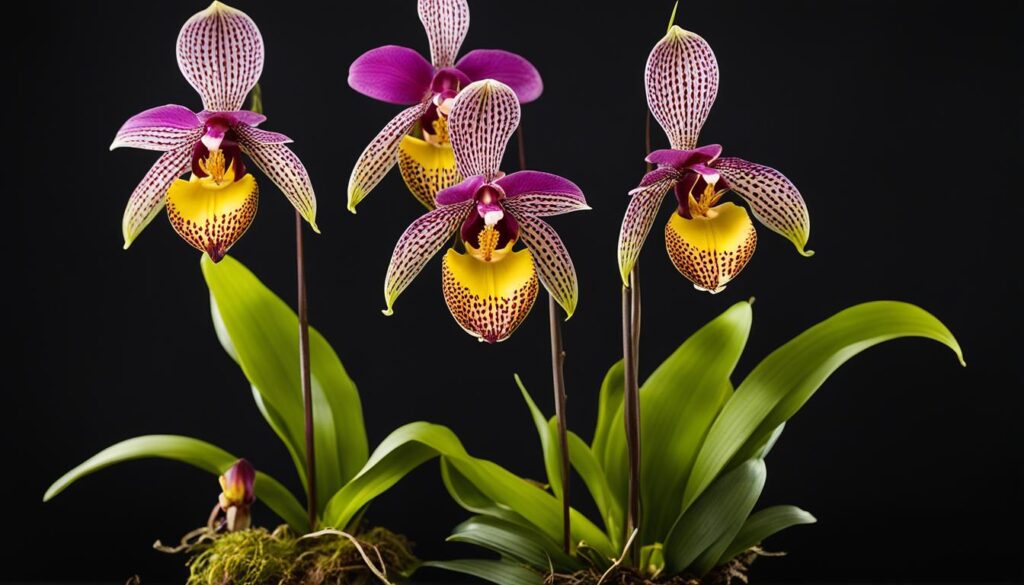
Unveiling the Unique Pouch-Like Lip of Lady Slippers
The distinctive feature of Lady Slipper orchids is indeed their pouch-like lip, which is not only an aesthetic wonder but also serves a practical purpose in the plant’s pollination process.
The intricate patterns of freckles and stripes across species like Paphiopedilum insigne or Paphiopedilum callosum are utterly captivating, adding to the exotic appeal that fuels the passion of orchid collectors worldwide.
Meeting the Needs of Lady Slipper Orchids in Your Collection
Cultivating these exotic orchid species requires a blend of patience, attention to detail, and a deep understanding of their needs.
Every variety of Lady Slipper orchid, whether rare or more common, presents its own set of requirements, from optimal lighting to precise watering schedules.
Here is a brief overview of how to cater to these needs:
| Orchid Type | Lighting | Watering | Temperature | Humidity |
|---|---|---|---|---|
| Paphiopedilum Maudiae | Moderate, diffused light | Keep moist; reduce in winter | Cool to warm | 40-50% |
| Paphiopedilum Delenatii | Bright, indirect light | Consistent moisture needed | Intermediate temperatures | Above 50% |
| Paphiopedilum Supardii | Low light | Evenly moist soil | Warm | 50-70% |
Understanding these specifics is essential for any orchid collector aiming to maintain the exotic beauty of the Lady Slipper orchids.
It is this complex web of care requirements that both challenges and rewards the dedicated grower, contributing to the profound satisfaction that comes with nurturing such an exceptional species.
The Striking Appearance of Brassia Orchids: Spider-Like Petals
As I explore the diverse world of orchids, I cannot help but be captivated by the unique beauty of Brassia orchids. Known for their distinctive spider-like petals, these enchanting flowers stand out among common orchid species. It’s like nature has spun a web of charm with these blossoms, creating a visual spectacle that’s hard to ignore.
For those identifying orchid types, Brassia orchids offer an intriguing case with their elongated and exotically patterned blooms.
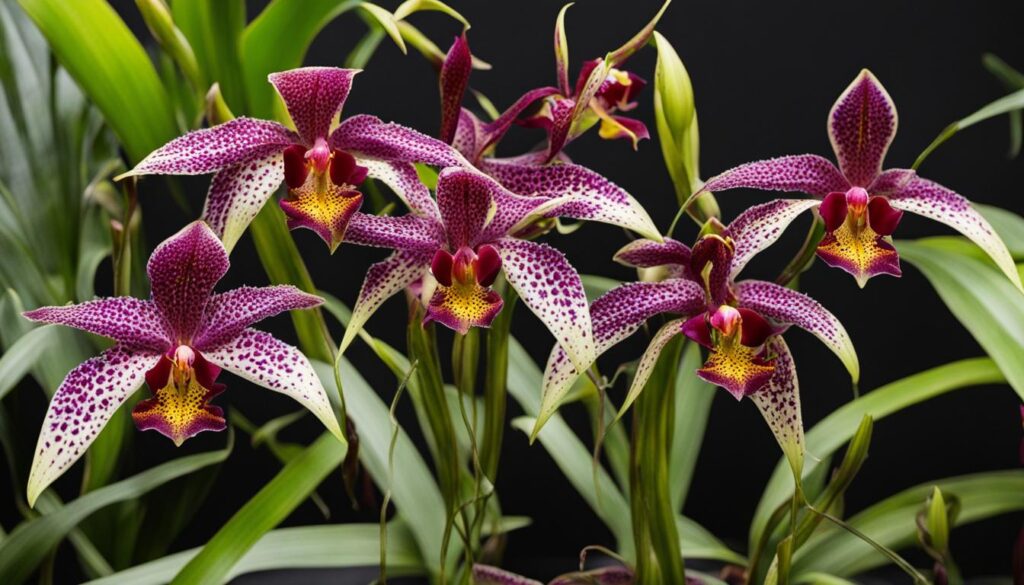
The allure of Brassia orchids extends beyond their day-time appeal; they are notably fragrant at night, coming to life to attract moths for pollination. This nocturnal perfume adds to the mystique of these orchids, making them a tantalizing subject for both amateur and professional horticulturists.
Furthermore, Brassia orchids, which are a part of the Brassavola genus, encompass over 20 different species, providing a range of options for collectors and enthusiasts.
| Brassia Orchid Species | Distinctive Features | Fragrance Profile | Pollinators |
|---|---|---|---|
| Brassia Rex | Large green-yellow flowers with chestnut markings | Sweet, spicy scent intensified at night | Moths |
| Brassia Eternal Wind | Long, slender petals with a gentle curve | Subtle, inviting fragrance | Moths |
| Brassia Nodosa | Smaller size, ideal for beginner cultivators | Light, almost citrusy aroma | Moths |
| Brassia Verucosa | Lush, spider-like flowers with pronounced markings | Sweetly intoxicating nighttime fragrance | Moths |
Among these, Brassia nodosa, commonly known as the ‘Lady of the Night’ orchid, is particularly friendly to novice growers. Its relatively small size and delightful, easy-going nature make it a perfect beginning point for anyone looking to start their journey with Brassia orchids.
Besides, the Brassavola genus is favored for hybridization, giving life to numerous hybrids exhibiting the best qualities of Brassia – further expanding the accessibility and variety of this fascinating group.
In cultivating these superb orchids, I find that providing high humidity and ample light during the day, coupled with cooler temperatures at night, can enhance their bloom and fragrance, coaxing out the true essence of these splendid creatures.
Truly, the Brassia orchids bring an unmistakable dimension to any collection, enchanting with their delicate forms and evocative scents.
Conclusion
Embarking on a journey through the world of orchid types has been like wandering through a perpetual spring, where the flora is as remarkable as it is boundless.
Each orchid species we’ve encountered represents a chapter in a grand horticultural narrative, from the undemanding Phalaenopsis to the discerning and stately Paphiopedilum.
These living gems underscore the beauty and complexity found in our natural world. As someone deeply enamored by their allure, I’ve discovered that part of the joy in identifying orchids lies in understanding their unique stories and origins.
Indeed, whether they hail from the steamy recesses of a rainforest or blossom quietly within city apartments, both exotic orchids and popular orchids share the inherent ability to transform spaces with their vibrant hues and intricate designs.
The range of common orchid species available today presents gardeners and collectors with an enthralling palette of choices, each with its optimal care techniques and specialized lore.
In my contemplation of these botanical marvels, I am continually in awe of their resilience and the evolutionary craftsmanship that carves out their place in our ecosystems and our hearts.
It isn’t just the enchantment of their beauty that holds my gaze, but also the ecological tales that each petal quietly narrates. For enthusiasts and novices alike, the world of orchids extends an open invitation to delve into a practice that is both an art and a science, revealing ever more reasons to cherish and preserve these extraordinary members of the plant kingdom.
FAQ
What is the Hardest Orchid To Grow?
The Masdevallia species can be considered one of the hardest orchids to grow due to its requirement for cool temperatures and high humidity, which can be challenging to replicate in a home environment.
What is the Easiest Orchid To Grow?
Phalaenopsis orchids, commonly known as moth orchids, are the easiest to grow, making them perfect for beginners. They are adaptable, forgiving, and bloom consistently, even with minor care mistakes.
What is the Lifespan of an Orchid?
The lifespan of an orchid can vary widely between species. Some may live only a few weeks, while others can thrive for several decades with the right care and conditions.
Which Orchid Blooms Continuously?
Phalaenopsis orchids are known for their continuous blooming cycles, often flowering multiple times a year when cared for properly.
Do Orchids Prefer Sun or Shade?
Orchid lighting preferences depend on the species. While Dendrobium orchids demand high light levels, Phalaenopsis orchids and several others thrive in low to medium light, preferring indirect sunlight.
What is the Immense Range of Orchid Species?
The orchid family comprises over 25,000 species globally, with endless variations in size, color, and shape, displaying a breathtaking diversity that continues to fascinate botanists and orchid lovers alike.
How Can I Distinguish Between Popular Orchid Types?
Popular orchid types such as Phalaenopsis, Cattleya, and Dendrobium can be distinguished by their unique bloom shapes, care requirements, and growing habitats. Phalaenopsis have wide, flat blooms, Cattleyas are known for their large, fragrant flowers, and Dendrobiums offer a rich color palette and diverse forms.
What Differentiates Native and Exotic Species Across the World?
Native orchid species have evolved to thrive in specific regional ecosystems, such as Encyclia tampensis in South Florida, while exotic species may come from far-flung locations, offering unique characteristics like the vivid colors of tropical Vanda orchids.
How Do You Care for Phalaenopsis Orchids?
Care for Phalaenopsis orchids involves providing them with indirect light, consistent moisture without waterlogging, and moderate temperatures. A well-draining orchid potting mix and regular fertilization will also help maintain their health and promote blooming.
What Are the Key Care Guidelines for Cattleya Orchids?
Cattleya orchids require bright, indirect light, high humidity, and well-draining media. They benefit from a dry period between waterings and a temperature drop at night to initiate blooming. Fertilize regularly but carefully, as over-fertilizing can harm them.
How Do You Cultivate Dendrobium Orchids?
Dendrobium orchids need a significant amount of light, slightly less during the winter. They prefer regular watering during their growing season, but should dry out between waterings. Good air circulation and proper fertilization are also crucial for their care.
Are Miltonia Orchids Similar to Garden Pansies?
Yes, Miltonia orchids, also known as pansy orchids, have blooms that resemble garden pansies, with broad, flat faces and striking patterns. This similar appearance has made them endearingly popular among plant enthusiasts.
How Can You Achieve a Fragrant Indoor Garden with Miltonia Orchids?
To nurture a fragrant indoor garden with Miltonia orchids, provide bright but indirect light, maintain high humidity, and ensure the potting medium stays evenly moist but not waterlogged. Their pleasant fragrance coupled with their beautiful blooms creates an enchanting indoor garden space.
What Makes Lady Slipper Orchids So Unique?
Lady Slipper orchids are unique for their striking pouch-like lip, intriguing patterns, and varying colors, which have made them highly sought after. They mimic the form of a slipper to attract insects for pollination, representing an exquisite adaptation within the orchid family.
What Are the Characteristics of Brassia Orchids?
Brassia orchids are known for their spider-like petals and distinct floral architecture, which is long, narrow, and star-shaped. This intriguing appearance, combined with their nighttime fragrance designed to attract moth pollinators, makes them a fascinating addition to any orchid collection.


Leave a Reply